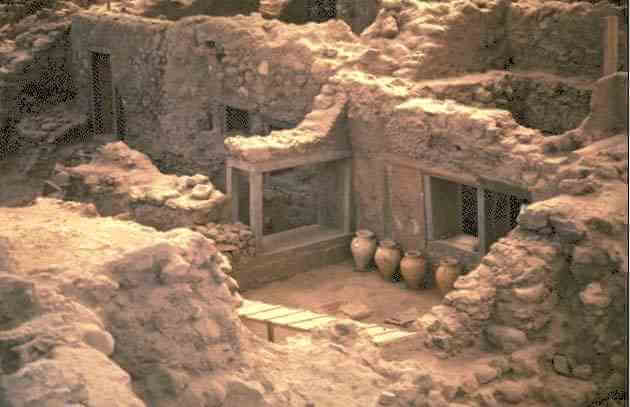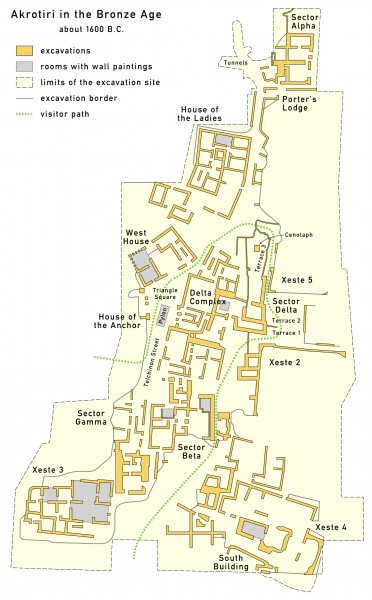
Thera

Brief Overview
Acrotiri of Thera
It is one of the most important prehistoric settlements of the Aegean. The first habitation at the site dates from the Late Neolithic times (at least the 4th millenium B.C.).
During the Early Bronze Age (3rd millenium B.C.), a sizeable settlement was founded and in the Middle and early Late Bronze Age (ca. 20th-17th centuries B.C.) it was extended and gradually developed into one of the main urban centres and ports of the Aegean.
The large extent of the settlement (ca. 20 hectares), the elaborate drainage system, the sophisticated multi-storeyed buildings with the magnificent wall-paintings, furniture and vessels, show its great development and prosperity.
The various imported objects found in the buildings indicate the wide network of its external relations. Akrotiri was in contact with Crete but also communicated with the Greek Mainland, the Dodecanese, Cyprus, Syria and Egypt.
The town\'s life came to an abrupt end in the last quarter of the 17th century B.C. when the inhabitants were obliged to abandon it as a result of severe earthquakes.
The erruption followed. The volcanic materials covered the entire island and the town itself. These materials, however, have protected up to date the buildings and their contents, just like in Pompei.
Thera and Atlantis:
The theory that Thera was the site of the capital of Atlantis was suggested by Angelos Galanopoulos in 1960.
Soon after the discovery of the Minoan civilization at Knossos on Crete by Sir Arthur Evans in 1900, theories linking the disappearance of this advanced empire with the destruction of Atlantis were proposed by K. T. Frost in 1913 and E. S. Balch in 1917.
This theory was revived by Spyridon Marinatos in 1950 and P. B. S. Andrews in 1967.
More recent archaeological, seismological, and vulcanological evidence (Recent arguments for Akrotiri being Atlantis have been popularized on television in shows such as The History Channel show Lost Worlds episode "Atlantis") has expanded the asserted connection of Crete, the island of Santorini, and the Minoan civilization with Plato's description of Atlantis. Evidence said to advance this idea includes:
The Minoan palace and buildings discovered at the digs at Knossos on Crete and at Akrotiri on the island of Thera have revealed that the Minoans possessed advanced engineering knowledge enabling the construction of three- and four-story buildings with intricate water piping systems, advanced air-flow management, and earthquake-resistant wood and masonry walls. This level of technology was, it is said, far ahead of that found on mainland Greece at the time.

Thera (also called Santorini) is the site of a massive volcanic caldera with an island at its center. Vulcanologists have determined that the island was engulfed by a volcanic eruption, the Thera eruption, around 1600 BC.
The event, referred to as the Minoan eruption, was among the most powerful eruptions occurring in the history of civilization, ejecting approximately 60 cubic km of material, leaving a layer of pumice and ash 10 to 80 meters thick for 20 to 30 km in all directions and having widespread effects across the eastern Mediterranean region.
Volcanic events of this magnitude are known to generate tsunamis and archaeological evidence suggests that such a tsunami may have devastated the coastal Minoan settlements on Crete.
Plato did not describe a volcanic eruption, although the events he described as "sunk by an earthquake" or "violent earthquakes, and only a flood (in singular)", could perhaps be interpreted as consistent with such an eruption and the resulting tsunami.
Plato described quarries on Atlantis where "one kind of stone was white, another black, and a third red", writing that these stones were quarried from the island and used in the construction. Rocks like this are found on Santorini.
The center of the metropolis of Atlantis was described as being laid out in circular manner, surrounded by three circular concentric pits of seawater and two earth-rings, each connected to the sea by a deep canal.
Docks for a large number of ships, with a causeway, were also mentioned. Scientists reconstructing the shape of the island prior to the eruption have concluded that there was a ring configuration with only one narrow entrance to a larger lagoon with islands inside, much as Plato described. One fresco in the ruins of Akrotiri is believed to be a landscape of the city. It shows a large city in an island in the center of the caldera lagoon.
The ancient Greek for "between" and "larger" are easily confused in transcription and translation, so "larger than Asia and Libya", might have originally read "between Asia and Libya", which is how Classical Greeks would have described Thera and Crete.
In Detail
EARLY SETTLEMENT
The earliest evidence of settlement on the island at Akrotiri (named after the nearby modern village) dates back to the mid-fifth millennium BCE when a small fishing and farming community established itself on a coastal promontory. By the third millennium BCE the presence of rock-cut burial chambers, pottery and stone vases and figurines suggest a period of significant growth. The marble used for these vessels probably came from the nearby islands of Paros and Naxos and together with finds of Theran pumice stone (used as a polish abrasive) suggest the presence of inter-island trade. Wood and food goods were also probably exchanged at this time, not only throughout the Cyclades but also with the Greek mainland and Crete.
Around 2000 BCE the settlement expanded further, and a disused cemetery was filled and constructed upon - both the fill containing pottery shards from large amphorae and black/brown burnished pottery (Kastri style) finds suggest healthy Aegean trade relations were in existence. Being strategically well-placed on the copper trade route between Cyprus and Minoan Crete, Akrotiri also became an important centre for metal work, as is evidenced by finds of moulds and crucibles.
URBANISATION AND DISASTER
From 2000 to 1650 BCE Akrotiri became more urbanised with paved streets and extensive drainage systems. Quality pottery was mass produced and decorated with lines, plants and animals. Metallurgy and other crafts (particularly those related to the maritime industries) became more specialised. In this period there is also evidence of repair and rebuilding projects following earthquake destruction.
Akrotiri's prosperity came to a sudden end with the massive and cataclysmic eruption of the island's volcano. Preceded by earthquakes of a magnitude of 7 on the Richter scale which destroyed the town and created 9m high tidal waves, the eruption itself probably occurred a few days later and released an estimated 15 billion tons of magma into the atmosphere, making it the largest volcanic eruption of the last 10,000 years. The entire island was buried in a thick layer of ash, Trianda on Rhodes was destroyed, 7cm of ash covered sites in northern Crete, Anatolia suffered from the ash fall-out and even ice-cores in Greenland demonstrate the far-reaching effects of the eruption. The precise date of the event is much debated amongst scholars with wildly different estimates vigorously defended in order to support various hypotheses for other events such as the destruction of Minoan palaces or Mycenaean imperialistic ambitions in the Aegean. The most agreed upon date ranges somewhere between 1650 and 1550 BCE (with ice-core and carbon-dating studies suggesting the earlier date).
Following the eruption of Thera, the town of Akrotiri was completely covered in volcanic ash and thereby remained extremely well preserved; for example, through negative casting it has been possible to identify usually perishable items such as wooden furniture, most commonly stools and beds. However, unlike at Pompeii where life seems frozen by the disastrous eruption of Vesuvius in 79 CE, at Akrotiri there were no casualties found at the site and there is evidence of some attempt to clear rubble which suggests that there was a short gap between the earthquakes and the eruption and many residents had already abandoned the town before the final cataclysm. The site remained hidden from sight until its systematic excavation from 1967 CE.
The well-planned town has squares and wide streets. Buildings were of two or three stories with flat roofs supported by a central wooden column. Architectural features in common with those in the Minoan civilization include a large hall, lustral basins, ashlar masonry, horns of consecration and the occasional lightwell.

ARCHITECTURE AND ART
Interestingly, almost all of the buildings excavated at Akrotiri have scenes painted on the interior walls in one or more of their rooms, illustrating that it was not only the elite who had such artwork in their homes. Fresco subjects and style were much influenced by the Minoan civilization - religious processions, goddesses, lilies, crocuses etc. and by the later Mycenaean civilization on the Greek mainland - griffins and boars' tusks helmets. More local themes such as girls gathering saffron, seascapes and fishing activities were also popular as were exotic animals such as antelopes and monkeys. Many rooms were completely covered in painted depictions of landscape scenes attesting to a love of nature and creating a powerful visual impact which transports the viewer beyond the confines of the room.
In addition to Fresco subject matter, other finds such as Cretan and Mycenaean pottery, seal impressions using Minoan iconography, Minoan clay loom weights, Canaanite jars, the use of the Minoan Linear A script and items of Egyptian origin (e.g.: ivory and ostrich eggshells) attest to Akrotiri's continued importance as an important trading centre with contacts throughout the Aegean.
Although the date of the event is difficult to fix, the effect of the disaster is clearly evident in physical archaeological remains but also in more intangible terms. It has been suggested that the eruption of Thera may be the origin of the Atlantis myth - the destruction of an island and with it the loss of an advanced civilization. From the point of view of Greeks in the so-called Dark Ages (from c. 1100 BCE) the Minoan/Mycenaean-influenced community on Thera may well have appeared as a golden age, a time when cultural and artistic achievements were greater than in the present time but in just a few days consigned to history by Nature's whim.
[1]
Official Website and Map
Further Sources
[1] "Ancient History Encyclopedia"
"Santorini.Com"
"Sacred Destinations"
Our Mobile Application
Check out Our Mobile Application "Ancient Greece Reloaded"


